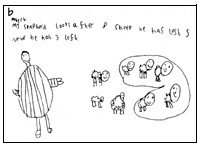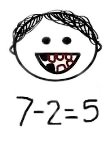
Subtraction Stages
Stage 1: Pictures and Objects
Children are encouraged to develop a mental picture of the number system in their heads to use for calculation. They develop ways of recording calculations using pictures, real life objects etc.
|
|
|
|
 As with addition, Numicon in used extensively to illustrate the concept of “difference” in subtraction. By placing the tiles over each other, the difference between them is made explicit.
As with addition, Numicon in used extensively to illustrate the concept of “difference” in subtraction. By placing the tiles over each other, the difference between them is made explicit.
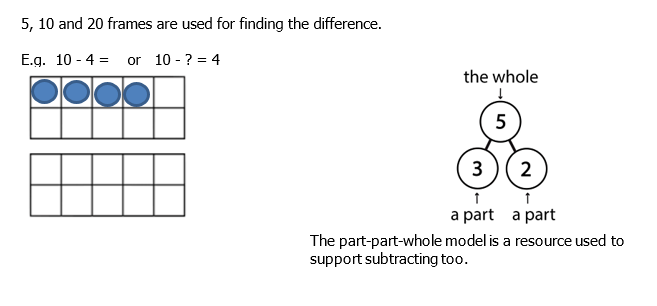
Stage 2: The Number Line
Children use number lines and practical resources to support calculation and teachers demonstrate the use of the number line. Count on and back and use terms such as “find the difference”.

The number line should also be used to show that 6 - 3 means the ‘difference between 6 and 3’ or ‘the difference between 3 and 6’ and how many jumps they are apart.

Children then begin to use numbered lines to support their own calculations - using a numbered line to count back in ones.

Stage 3: The Empty Number Line
Most children should be able to use and empty number line to count on or back by the end of Year 2. The empty number line helps to record or explain the steps in mental subtraction. A calculation like 74 – 27 can be recorded by counting back 27 from 74 to reach 47. The empty number line is also a useful way of modelling processes such as bridging through a multiple of ten.

 The steps can also be recorded by counting up from the smaller to the larger number to find the difference, for example by counting up from 27 to 74 in steps totalling 47.
The steps can also be recorded by counting up from the smaller to the larger number to find the difference, for example by counting up from 27 to 74 in steps totalling 47.
With practice, children will need to record less information and decide whether to count back or forward. It is useful to ask children whether counting up or back is the more efficient for calculations such as 57 – 12, 86 – 77 or 43 – 28.
The mental method of counting up from the smaller to the larger number can be recorded using number lines.
Stage 4: Supported Column Method
This method will be taught to most children from the start of year 3 as an introduction to a columnar method for recording addition. The use of resources (Dienes base 10 apparatus and place value mats) are crucial to support this method. A sound knowledge of place value is necessary at this stage.
The formal recording with the columnar layout mirrors the practical use of the Dienes apparatus and is recorded alongside the practical procedure.
Vocabulary:
“start with the units”, “regroup”
Example without regrouping:
 Step 1:
Step 1:
As with addition, Dienes apparatus is used to represent the calculation. However, for subtraction, only the larger number in the calculation is represented on the place value mat in the correct columns.
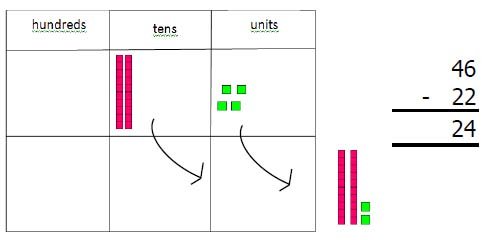 Step 2:
Step 2:
“Starting with the units”, the smaller number is physically taken away from the Dienes representation of the larger number.
The resulting totals of “units” and “tens” left on the mat are written simultaneously in the column layout to reinforce what is happening.
Example using regrouping:
 Step 1:
Step 1:
Again, Dienes apparatus is used to represent only the larger calculation on the place value mat in the correct columns.
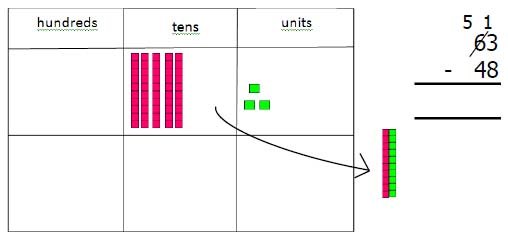 Step 2:
Step 2:
“Starting with the units”, the smaller number is physically taken away from the larger number. Here, children will recognise that we can’t subtract 8 from 3 as we don’t have enough units in the units column.
So we regroup one of the ten sticks from the tens column into ten unit cubes and move them into the units column. We now have 5 tens sticks in the tens column and 13 units in the units column. This is mirrored in the written calculation.
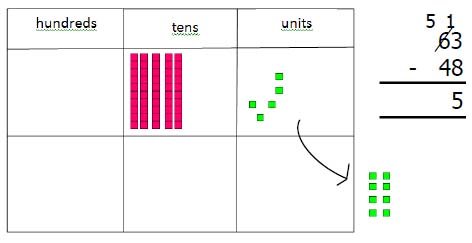 Step 3:
Step 3:
The 8 units can now be subtracted from the 13 units, leaving 5 in the units column. This is recorded in the written calculation.
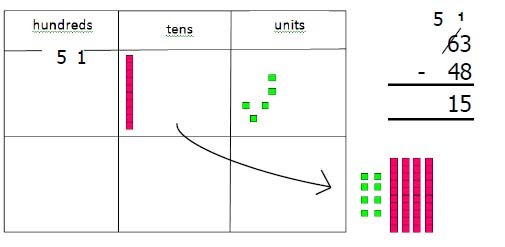 Step 4:
Step 4:
Finally, the 4 tens are subtracted from the 5 tens in the tens column to leave a resulting total of tens which is recorded in the written calculation.
Most children will use this method from year 3 to subtract numbers with up to three digits. Regrouping hundreds into tens will be necessary when dealing with these larger calculations:
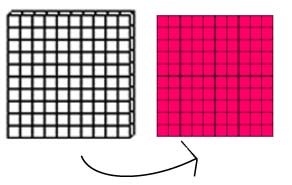 One hundred flat can be regrouped into ten ten sticks.
One hundred flat can be regrouped into ten ten sticks.
Stage 4 extended: Jottings
Once children are familiar with using dienes apparatus, they should quickly move to recording their workings using jottings. This gives children the ability to find the answer without using apparatus. This method is shown below:
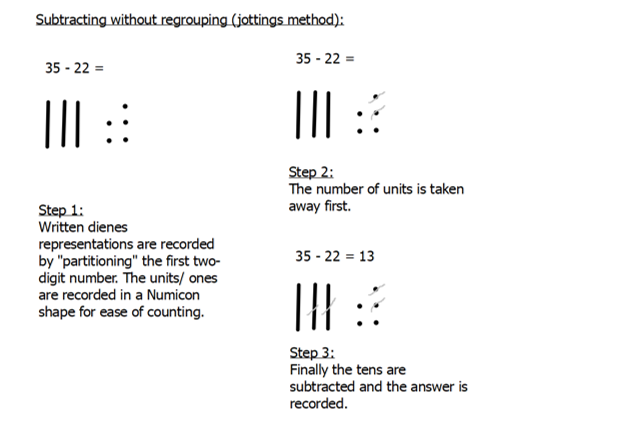
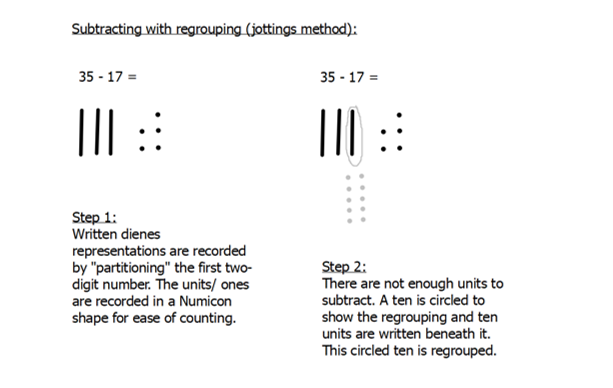
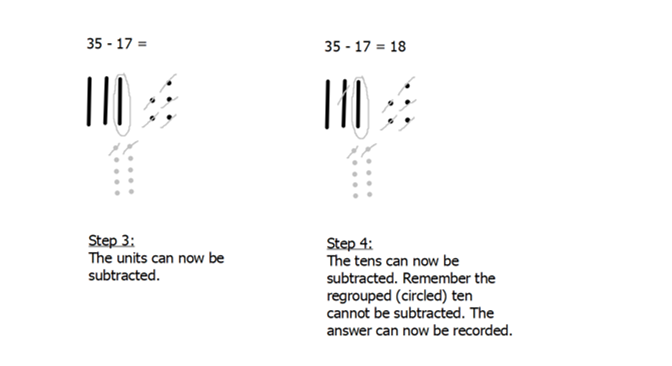
As with addition, the bar model provides a strong visual representation to support subtraction in the context of real world problems. Each number within the problem is represented by a bar, showing the unknown total as a blank bar. This is also reinforced through the use of Cuisenaire rods to mirror the bar model. The jottings method can be used to find the answer.
|
|
This time, the unknown answer represents the “difference” between the 2 amounts in the calculation. |
Stage 5: Column Method
Most children should be secure in this method by the end of Year 4. Through use of the apparatus and supported column method procedure, children will become confident to record just the written calculation in column format. Earlier use of concrete apparatus reinforces the understanding of where the regrouped tens or units have originated from.

By the end of year 5 children should extend this method to subtraction of any number of digits. Column subtraction remains efficient when used with larger whole numbers and decimals. Once learned, the method is quick and reliable.
- Rectory Gardens, Worthing
West Sussex, BN14 7TQ - OFFICE@BROADWATERCE.ORG
- 01903 235389


